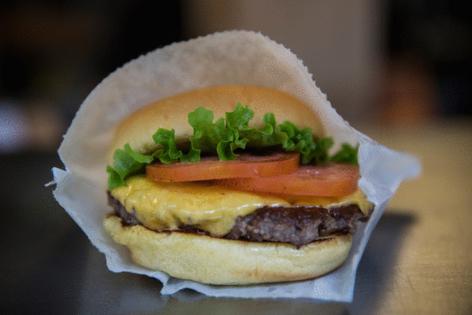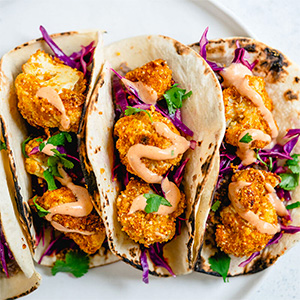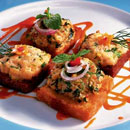Column: Burgers are the restaurant world's safe haven
Published in Variety Menu
With apologies to John Milton, a hamburger is often the final infirmity of a noble restaurant.
When times get tough, even the best chefs will succumb to the popular appeal and simple economics of a ground beef patty slid between well-buttered buns. Cheap chopped meat can conceal a lot of shortcomings and do wonders for the bottom line.
Nowadays, the financial incentives are more compelling for high-end establishments than burger joints. Inflation has pushed up the cost of beef — as much as 20% over the last 12 months, according to UK’s Office for National Statistics — so fancier spots can sell a pricey burger that’s still a bargain for their clientele. Depending on how you weight your cost-benefit analysis, you might opt for, say, a Gordon Ramsay burger rather than fast food in a box on a plastic tray. Currently, the two-for-one Whopper deal at Burger King in the UK will set you back about £12 ($16.20). That’s with a coupon. Without a promo discount, you may have to lay out almost £8 for just one. Some estimates have the Whopper increasing by a whopping 45% since 2020. In comparison, you can get a posh burger and brag about the famous culinary reputation attached to it for around £18. (Unless you want it with tender wagyu beef, which will cost you extra).
Imparting an uptown sheen to down-market cuisine is an age-old ploy. At steakhouses — like the 137-year old Peter Luger in Brooklyn, New York — unused cuts of meat that didn’t become sirloins, porterhouses or filet mignons were ground down and put to profitable use. Not only did the resulting burgers make customers happy, they sustained and buttressed the margins of the business. At the Grill in Midtown Manhattan (which occupies the Philip Johnson-designed space of the legendary Four Seasons), whatever’s left from the previous night’s $98-a-person prime rib is available off-menu — first come, first served — as heaving sandwiches at lunch for around $30 each. In London, poulet roti — homey, French-style rotisserie chicken available ready-to-eat at Paris supermarkets for about €9 (£7.80 or $10.50) — is newly fashionable, with wonderful incarnations in Shoreditch (The Knave of Clubs) and East Dulwich (Norbert’s), £38 and £30 respectively for a whole bird.
The hamburger is the protean protein of the age of American hegemony. There’s one story that Jewish immigrants to New York traveling on a ship called the Hamburg were responsible for sparking its popularity in their new homeland. Forget old Europe: Hamburg has a better claim on the Beatles than on the hamburger, even if there is a German fried meatball recipe dating from the 18th century. There are versions out of Scandinavia and Poland as well. Like all archetypal entities, its real beginnings are mysterious.
By the time dishes bearing the name hamburger (or Hamburg steak) proliferated in the US, variants were cooked on a griddle or presented raw and topped with an egg. In some versions it was poor man’s fare, but a menu item by the name was also one of the most expensive at the legendary Delmonico’s restaurant, which was founded in 1837. Vendors served it between slices of bread at the 1904 St. Louis World’s Fair — an apogee of America’s Gilded Age — and it soon became part of the country’s culinary vocabulary and a mainstay of fourth of July barbecues and family reunions.
It also became a manifestation of American business enterprise as it set off on world conquest. White Castle, a pioneering burger franchise, was founded in 1921; McDonald’s was established in 1940 before Ray Kroc bought it in 1961 and turned it into a global phenomenon. Since then, there’s been Wendy’s, Carl’s Jr., In-and-Out, Five Guys, Smashburgers, Shake Shack and on and on, plus innumerable corner burger bistros. It’s also become a cross-border barometer of global living standards as embodied in The Economist’s Big Mac Index — which compares the varying prices of the double-decker McDonald’s burgers in cities across the world. The photojournalist Gary He has published a marvelous look at the adaptability of McDonald’s across cuisines and cultures in McAtlas, which won two James Beard media awards this year.
Much like the US dollar, the hamburger has become the safe-haven cuisine of haute restaurants in trouble. Still, a whopper by any other name is not necessarily a culinary feat. After a string of particularly awful greaseballs in the US, I gave up burgers for a few years. But then Shake Shack began doing special editions of its burgers in collaboration with top-ranked chefs, including ones I admired here in London. This year, Jackson Boxer recalibrated his Notting Hill restaurant Orasay, renaming it Dove and revamping the menu. The much-hyped draw: an off-menu hamburger. Only 10 were prepared for each service (lunch and dinner), so you had to book a table at Dove when the doors opened to get a chance at it.
I had to get in on it. Boxer has one of the best palates in London so I wasn’t surprised his burger was a gustatory thrill — thick and messy and oozing with gorgonzola and beefiness. Everyone who scored an early table ordered a burger — and a bunch of other dishes on the menu — as did I.
But what moved me was an unexpected ingredient: nostalgia. Maybe it was just me, but it revived remembrances of very good patties past. I was heartened to read that Boxer was inspired by the burgers produced by the British-born chef April Bloomfield who found fame with the Spotted Pig in New York in the early 2000s. I love her cooking. I found myself reminiscing over the juiciness and char of burgers I had as a child at the Manila Polo Club, from long vanished days of family privilege. Who knew that a burger could be a madeleine?
____
This column reflects the personal views of the author and does not necessarily reflect the opinion of the editorial board or Bloomberg LP and its owners.
Howard Chua-Eoan is a columnist for Bloomberg Opinion covering culture and business. He previously served as Bloomberg Opinion's international editor and is a former news director at Time magazine.
©2025 Bloomberg L.P. Visit bloomberg.com/opinion. Distributed by Tribune Content Agency, LLC.










Comments